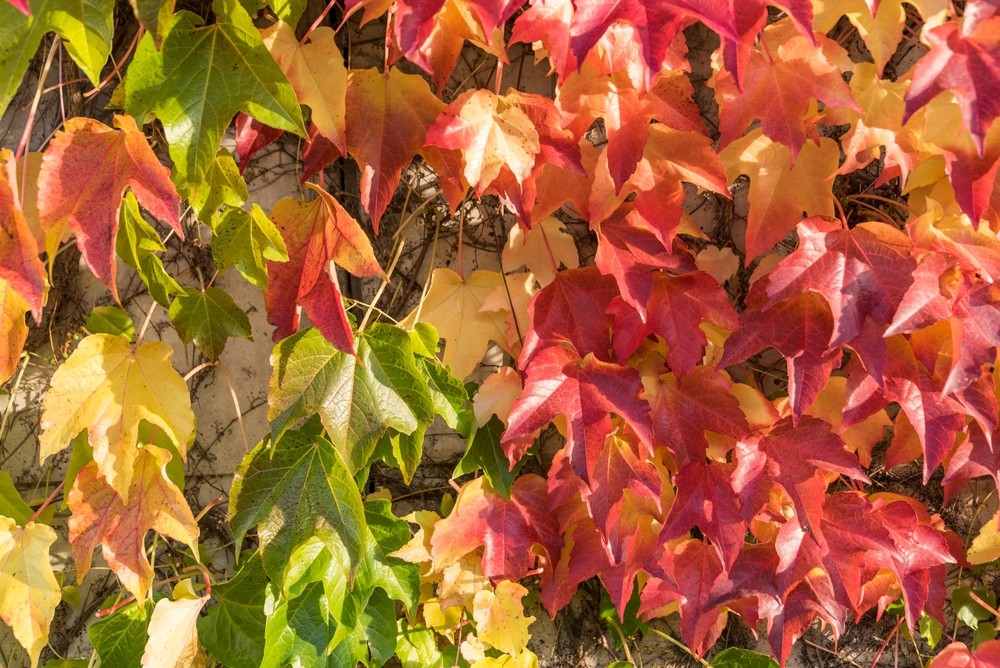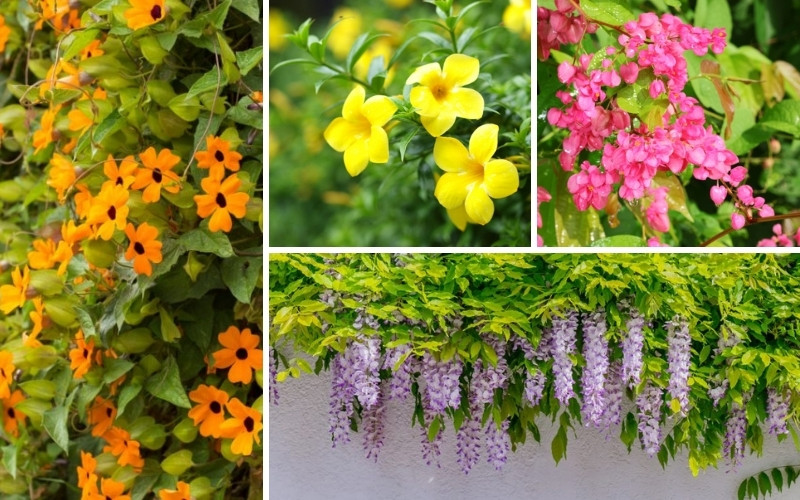Many flowering vines are native to Virginia and make an excellent addition to your garden, whether in texture or color.

Since most flowering vine types are perennial, you get to enjoy their blooms every year. Plus, they attract various kinds of pollinators, which is especially useful for all surrounding plants.
Take a look at the 10 best Virginia flowering vines, their characteristics, and how to care for them.
1. Coral Honeysuckle (Lonicera Sempervirens)

Native to zones 4 to 9, Coral Honeysuckle is a low-maintenance type of vine. Moreover, it’s quite a delight to have in your garden.
This twining climbing plant can reach 6 to 20 feet in length and has glossy semi-evergreen leaves.
From March to June, Coral Honeysuckle blooms red tubular flowers. Eventually, these flowers mature into bright red berries.
Soil: Well-draining, loamy soil
Light: Full sun/partial shade
Water: One inch of weekly watering
2. Yellow Jessamine (Gelsemium Sempervirens)

Yellow Jessamine is another variety of flowering vines known for their fine ability to climb nearby trees and structures. The native distribution of this vining plant is through zones 7–8.
This evergreen vine grows as high as 20 feet and produces dark green foliage, developing a yellowish, bronzy patina in winter.
Blooming late winter to early spring, Yellow Jessamine blooms yellow flowers that look like a trumpet and smell quite amazing.
Soil: Humus-rich, well-draining, moist soil
Light: Sun/partial shade
Water: Twice weekly for two months until established
3. Virginia Creeper (Parthenocissus Quinquefolia)

What’s fascinating about the Virginia Creeper is that it can reach up to 40 feet long, whether crawling vertically or climbing horizontally.
This vining plant thrives in hardiness zone 3–8, and it’s known for its amazingly colorful fall foliage, ranging from dark orange to burgundy.
In the summertime, Virginia Creeper blooms tiny greenish-white flowers and produces dark blue berries. Though birds can eat those berries, they’re toxic to humans.
So, it’s better to be careful when handling this plant.
Soil: Sandy, clay, or loamy soil
Light: Full/partial shade
Water: Deep regular watering until established
4. Virgin’s Bower (Clematis Virginiana)

Virgin’s Bower grows in hardiness zone 3–9 and is one of the few vines that flower in the shade.
It’s a deciduous plant that can climb surrounding trees up to 20 feet high or even crawl to cover the ground.
The plant’s foliage grows in groups of three trilobed leaves. As for flowering, Virgin’s Bower produces separate male and female blooms on two separate plants.
From late summer to fall, you can notice the fragrant pure white blooms growing in masses all over this vine.
Soil: Fertile silty or loamy soil with above-average moisture levels
Light: Full sun/shade
Water: Average moisture with no accumulating water
5. Crossvine (Bignonia Capreolata)

Coming from the trumpet creeper family, this vine is a vigorous grower native to USDA zone 6–9. It’s famous for its ability to cling to just about any surface material.
Crossvine can reach up to 50 feet long and grows deep reddish orange trumpet-shaped flowers from March to May. This makes it an excellent plant for covering trellis or walls.
Soil: Acidic or calcareous soil with adequate drainage
Light: Sun/partial shade
Water: One inch per watering when the soil is completely dry
6. American Wisteria (Wisteria Frutescens)

This woody deciduous vine can grow to reach 30 feet high and is known for its gorgeous cascade of purple flowers.
Although it’s a great vine option in your garden, you might have to wait at least five years for this plant to flower.
Being native to USDA zone 5–9, American Wisteria has pinnate leaves bearing 9–15 leaflets. It blooms from May to June, producing six to nine inches long clusters of droopy flowers.
Soil: Rich, slightly acidic, and well-draining soil
Light: Sun/partial shade/ full shade
Water: Once established, water weekly until the soil is moist
7. Maypop (Passiflora Incarnata)

Maypop thrives in zone 5–9 and is a tendril-climbing, vigorous-growing evergreen plant. This herbaceous vine growing up to 25 feet long blooms around summer and early fall.
Not only does this plant grow a stunning purple passionflower, but it also produces an edible fruit that makes a popping sound when stepped on. That’s why it’s called Maypop.
Maypop’s passion flowers attract all various kinds of pollinators, from bees to birds. The plant also acts as a larval host for many butterflies.
Soil: Any kind is fine as long as it’s well-draining and moist
Light: Sun/partial shade
Water: One inch of weekly watering
8. Atlantic Pigeon Wings (Clitoria Mariana)

This perennial vine grows three to four feet long and is native to many U.S. areas, especially zones 5–9.
Although it has trailing stems, the Atlantic Pigeon Wings rarely climbs any surroundings. Instead, it stays close to the ground.
From June to August, this vine produces pinkish-lavender flowers resembling a funnel or a mouse’s ear.
Soil: Dry sandy soil
Light: Sun/partial shade
Water: Regular watering/average amount
9. Trumpet Vine (Campsis Radicans)

This woody climbing vine is widely known for its showy orange-red trumpet-looking flowers. Native to USDA zone 5–9, Trumpet Vine blooms during the summer.
This plant can reach up to 40 feet high and has large glossy elliptical leaves with 7 to 11 serrated leaflets.
As for the blooms, they grow in clusters, with each flower reaching up to three inches long. After wilting, these colorful flowers give way to seed capsules that look like beans.
Soil: Adapts to any kind of soil
Light: Sun/partial shade
Water: Only when showing signs of wilting
10. American Bittersweet (Celastrus Scandens)

This twining woody vine is fast-growing and well-known for its colorful fruits. Climbing to a height of up to 30 feet, American Bittersweet has male and female plants.
It thrives across the U.S. from zone 3b to 8 and has ovate green leaves that turn yellow in fall.
American Bittersweet produces small greenish flowers from May to June, followed by orange and red berries.
Soil: Any kind of well-draining, moist soil
Light: Full sun/medium sun/average shade
Water: Soak the ground only during dry conditions
Conclusion
Among the 10 best Virginia flowering vines are some options with colorful blooms and fruits as well. All of them can be a cheerful addition to your garden.
However, be careful when handling some of these plants, as they may be toxic to humans and pets.













